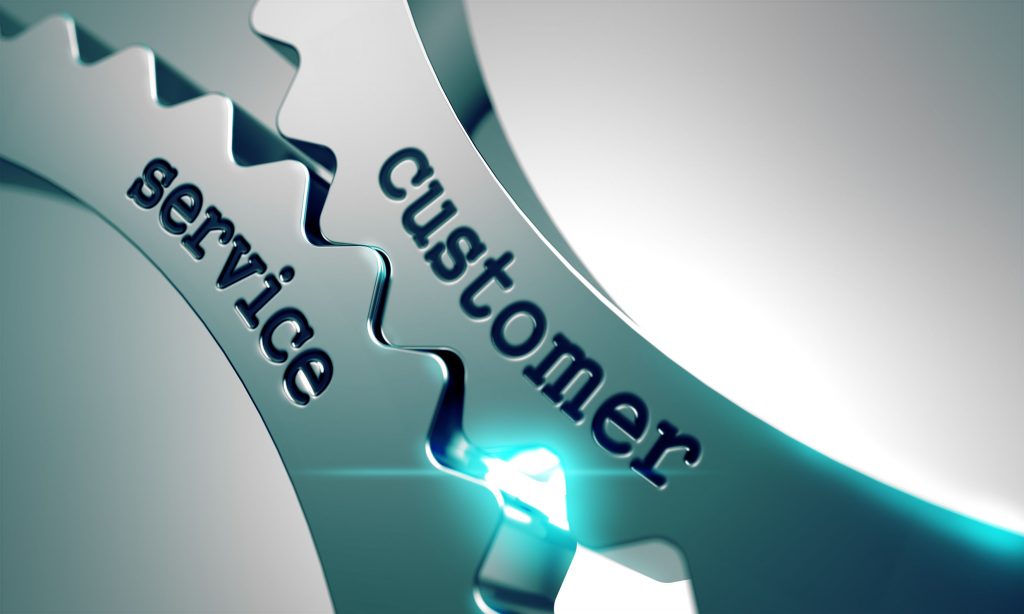Customer Service in the New Digital Age: The critical factor for business success, going forward
Are you into retail or work for a B2B, B2C, or online firm as a Customer Experience manager; do you know that how you approach customer service in the new Digital Age would – to a large extent, determine if the opportunities/threats arriving with Industry 4.0 would work for you or consume you?
As with every disruption the world has battled and eventually come to terms with, be it a slow evolution or a rapid revolution, change always come about with a severe birth pang that is never comfortable – even when such a change is necessary for growth and development.
The 4th industrial Revolution is no different, and it would shape, or reshape, much of the world in all ramifications, including the way we live, play, work, school, do business, and more.
At the forefront of this change is customer service, considering that it is the frontline – the nexus between the customer and the company aiming to sell its goods and services to potential and return consumers.
The customer of tomorrow: A different kettle of fish altogether
 The gig-economy-loving millennials of today are not only changing how companies and brands create and market products, but this restless generation is also demanding a complete makeover of enterprises that wish to sell to them – and that is just the scratch of it.
The gig-economy-loving millennials of today are not only changing how companies and brands create and market products, but this restless generation is also demanding a complete makeover of enterprises that wish to sell to them – and that is just the scratch of it.
As millennials begin to have children of their own and take over management positions in big corporations and multinationals, their idea of how the world should look, how they want to access goods and services, and how they want to relate with businesses eyeing their wallets is already shaping business enterprises in all ramifications.
From market research to product design, manufacturing, and distribution, the millennial-led digital revolution hinged on a combination of the internet, smartphones, and wearable tech is, perhaps, the most significant and swiftest game changer the business world has ever witnessed.
Hence, experts and practitioners are beginning to redefine customer experience to fit this generation’s – and their children’s – desires.
It is no surprise then, that customer service practitioners readily agree that price is no longer king; they align with the reality that businesses wishing to thrive must find a new differentiator that stands them out from the competition.
Similar:
The customer in the 4th Industrial Revolution

Similar to the above, even the most cerebral of economists would agree that ‘price point’ is no more the key differentiator that separates competing businesses as it has primarily been in the Manufacturing Age.
Since distance and national jurisdictions have become practically inconsequential to the modern buyer, the key differentiator as far as buying and selling are concerned now lies in customer experience.
In a few short years after the birth of the smartphone and online shopping, how a company satisfies its customers (both existing and new) in the Digital Age has become the most significant factor that separates successful businesses from failures.
Customer experience is not a scientific or objective element but, rather, a fluid, subjective, and people-centric engagement that demands a high level of emotional intelligence when dealing with the consumer of goods and services.
In other words, a business concern must, as a matter of necessity, focus on the needs, interests, and expectations of the customer, making sure that they not only understand those interlinked elements but go on to design their products – and company structure – in response to such realisations.
The customer is king, after all!
Keeping up with the tech: A need to adapt or die!
 Due to the rapid disruption brought about by Industry 4.0, companies that aim to stay ahead of the competition and retain the loyalty of their customers must first redefine who that customer is and then design the whole of their business model around that buyer – the Digital Age customer.
Due to the rapid disruption brought about by Industry 4.0, companies that aim to stay ahead of the competition and retain the loyalty of their customers must first redefine who that customer is and then design the whole of their business model around that buyer – the Digital Age customer.
The customer in the 4th Industrial Revolution is no more a demographic or a statistic; the consumer of now – and into the future – is a single individual.
This customer is a mom with particular shopping habits, the consumer of tomorrow is that teen with a specific allure to pink colours.
The buyer of your product is not a number, he is a human, a young man who prefers to shop on the 15th of every month instead of joining the long queue at the end of the month; she is or Alice, the grandma whose wittiness will give Hardley Chase a run for his money.
Your customer is a “he” and a “she,” not a number!
You must know your customers, their habits, and normal shopping behaviour. There is no shortcut to it!
Said otherwise, using the readily available data (sourced from social media and other digital platforms) to identify and adequately segment each individual consumer is the key to customer retention in the Digital Age.
Knowing how to obtain data from smart-shopping digital processes and signup details from your online freebies campaigns as well as info gleaned from social media listening and monitoring crawlers, among other tools (in an ethical manner), is becoming one fundamental differentiator separating dinosaur-like businesses from those adapting accordingly.
It does not end with collecting the data; analysing such data and using artificial intelligence bots to properly segment the customer’s shopping behaviour, needs, interests, and expectations will give the winning company an edge.
Who says data is not the new crude oil, the most valuable currency in this new Digital Age?
READ ALSO:
The Future of IT Security in the Digital Age: An Opportunity for Africa to Arise!
Satisfying the customer’s desires: The need for a holistic structural change

Is the staff digitally ready to respond to new customer needs?
Such is the fundamental nature of the question every executive and member of the management team need to be asking at this moment.
Existing businesses need to rapidly adapt to the imminent change if they want to be seen providing excellent customer experience as expected by today – and tomorrow’s customers; they must be deft, yet, robust enough to learn, unlearn, and relearn on their feet, evolving with the times and flowing with the tide continuously.
This adaptation demands a total overhaul of the brand’s systems, structures, strategies, and style.
A lot of research and scholarly works have focused on this area of study, and they all agree that happy and appreciated workforce is key to first-rate customer experience and retention.
In effect, the winning brand will require its entire staff to upgrade their skills in response to what the Digital Age demands just as it evaluates its shared values to ensure that it is customer-centric from start to finish.
The winning formula would be to properly analyse all the stakeholders in the value chain and not just the buyers alone; in other words, to look at the structure holistically.
Doing so would help management to understand customer engagement better and this will, in turn, prompt them to design, or redesign, the business to achieve quality customer experience as far as the brand, its products or services are concerned.
In summary, the customer is not only the man or woman or teen who unzips his or her wallet or swipes his or card at the till, but the customer is also the whole value chain, every stakeholder involved in the process – including the staff, suppliers, and the entire gamut.
The staff and management is the Sales Team

Redesigning the company structure means tweaking the organisational culture to upskill everyone in all departments so that a measurable ROI can be determined even before investing in achieving better customer experience.
To do this, the enterprise should not mandate (read: abandon) only the sales team to interact with the customer; it must drive strategy and organisational culture through every single staff in the workforce.
Said otherwise, the executive and management must get on board and flow with the change in the 4IR to make it organisation-wide and not just rhetoric in the board room where endless slides and hot coffee are the order of the day.
The organisational change should not happen in a silo involving top management and selected staff alone, but with everyone in the organisation – from the fellow at the gate to the CEO sitting on the big chair.
Every single person must upskill to become an excellent customer experience champion, one who uses customer data to analyse consumer behaviour and work diligently to satisfy every customer – individually!
By so doing, the HR department would have created a team of lateral thinkers, a single organism made up of well-trained staff and management that do not need to be specialists per se, but generalists that have a good understanding of the brand’s value chain and can contribute positively to creating that ‘wow’ customer experience.
Machine-power combined with soft skills make for the best customer experience champion
While business firms strive to interface digital platforms with real human interactions as we transit fully into the Digital Age, management must concentrate on integrating a purposeful and well-integrated customer-centric model into their business design by injecting the human touch into the incredible capacity of AI and automation.
The business outfit that would remain relevant and, at the same time, sustain customer loyalty would be the one that integrates human emotional intelligence, creativity, and non-repetitive manual dexterity with technology.
This integration will create multiple customer design thinking experts in the organisation, thereby achieving a culture change (gradual evolutionary cultural transformation) and an inevitable tech change (rapid revolutionary adjustment)
LEARN MORE:
Customer Experience in the 4th Industrial Revolution: Adding EQ ‘into’ AI
The kind of customer experience your consumers want in the New Digital Age

Whether your business requires or does not need to be a fully digital platform, the kind of customer experience that would keep you winning would be such that applies the human touch.
It will be the type that will engage customers in a smart and empathetic manner, thereby turning in quick feedback from which you can further analyse and understand the degree of customer frustration (or satisfaction).
Such invaluable information will, in turn, help you tweak your systems and structure to meet customer expectations.
This outcome is the kind of customer experience that resonates with the human heart and feeling, priceless feedback and emotional elements that will guide you as you make your next business decisions.
Click here to apply for a degree that will enable you to become the modern Customer Service Manager of your dreams
Takeaway*
In the end, it’s all about adaptability; not drowning with the crowd and giving in to the fear of Industry 4.0.
A well-trained retinue of staff that can be adaptable, yet, individually equipped with a portfolio containing a collage of diverse human relations skills working in a multigenerational organisation and desperately hungry for change will help you achieve that.
The bots are here right now, and they are here to stay – get over it!
End.
*Being outcome of a panel discussion on Customer Service in the new Digital Age held at Regenesys Business School, Sandton, Johannesburg on the 1st of August, 2019.
The Panel comprised of Industry Subject-Matter Experts, Practitioners and Executives from various sectors of the economy, the Academia, and the Public.
The Panelists included:
Isvari Naidoo, Digital Omnichannel Manager, COCA-COLA
Penelopé Khuzwayo, Strategic Marketing, Customer Experience and Insights, SUN INTERNATIONAL
Marvel Mandaza, Manager: Customer Experience Design, MTN
Craig Stewart, General Manager: Customer Experience (CX) and Collaboration, DIMENSION DATA
Marc Emert, Transforming Customer Experience, SAP
Kewyn Buttle, E-Commerce Manager, COMAIR
Shouneez Baghas, Head of Guest Experience, STER KINEKOR
Shirley Mangena, HR HOD, PICK N PAY
Chuvasen Govender, Customer Services Manager, HEINEKEN
…and
Professor Mervyn King, Patron, THE GOOD GOVERNANCE ACADEMY





